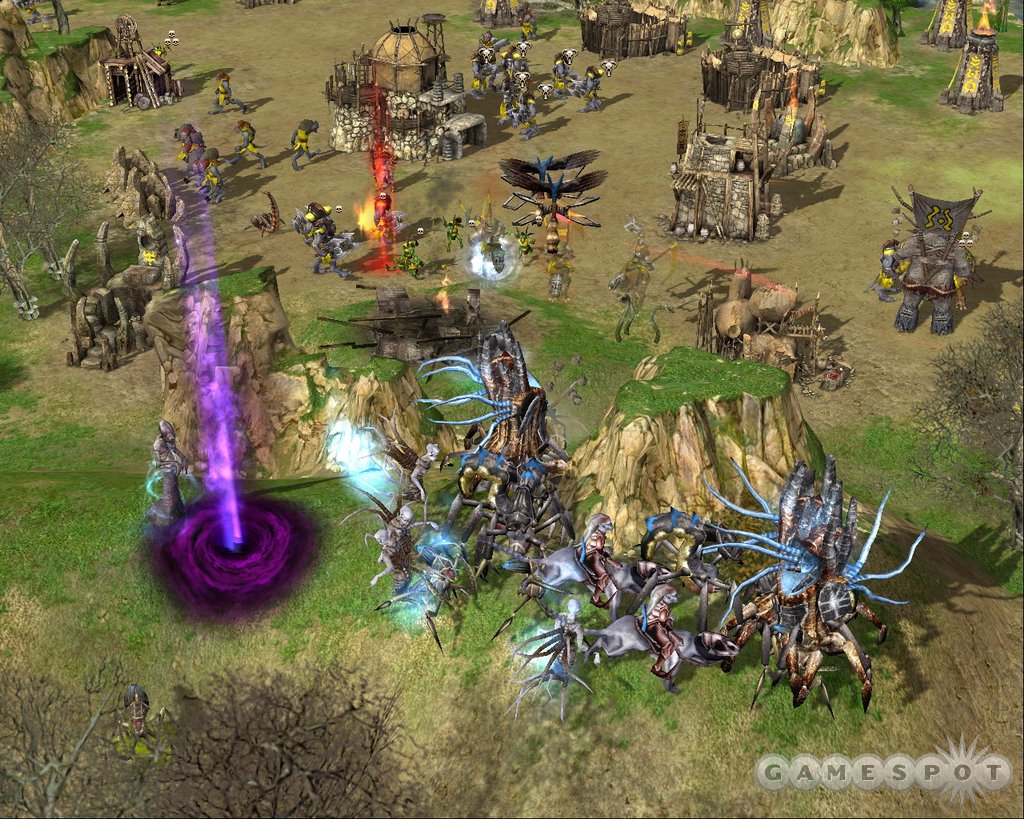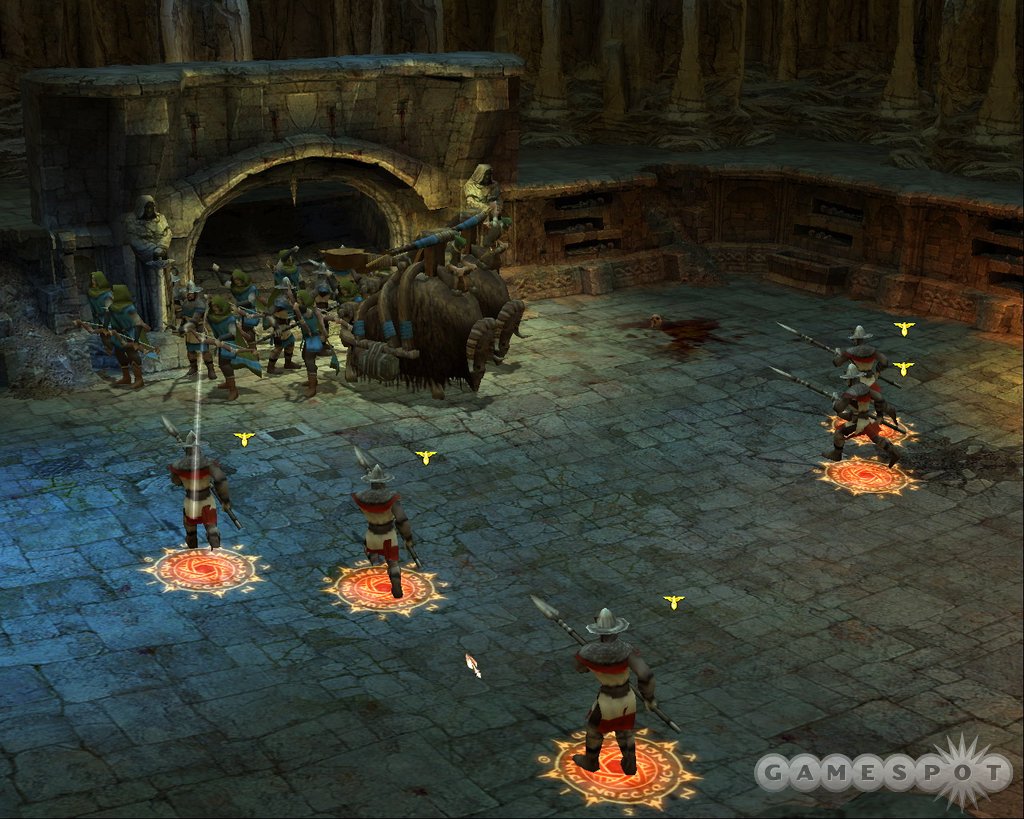Armies of Exigo Q&A - Overview
Producer Matt McKnight describes what you can expect from this real-time strategy from the studio that brought you such motion-picture classics as <i>Die Hard</i>, <i>Rambo</i>, and <i>Total Recall</i>
Real-time strategy games used to be criticized for being all the same: You invariably started them off by using peasants to gather resources, you built a base, and then you built an army to crush your enemies as quickly as possible (or else you'd suffer a similar fate yourself). Thankfully, this no longer seems to be the case, since many games are incorporating plenty of interesting new features. One of these will be Armies of Exigo from EA Games and Black Hole Games--a developer that is home to some of the same motion-picture talent that helped produce big-screen action movies like Terminator 3 and Die Hard. Armies of Exigo will be an unusual fantasy-themed game that lets you play as one of three factions--the humans, the beasts, and the evil fallen--to battle for control of a fantasy world. In fact, you'll battle both above ground and below it. Producer Matt McKnight explains.
GameSpot: We've heard a bit about the story that brings together the game's three factions of humans, beasts, and the fallen, but what can you tell us about the story without giving it away? Are the factions fighting over resources, territory, or just sole survivorship? And how does this figure into the single-player game?

Matt McKnight: Two of the races, the beasts and the Empire (the humans), have been fighting each other for centuries. Many of the battles have been territorial, as the humans have tried to expand and have come into conflict with the beasts. The beast race adheres to tribal ways. Now, enter the fallen race. Their home planet is dying, and their race is on the verge of extinction. They have come to live beneath the surface of the world where the humans and the beasts reside so that they can build a large army. Their goal is to unlock the secret of a magic stone that will open a portal to their world. Through the portal they can then bring the rest of their people from their dying planet. When the Empire and the beasts finally realize the goal of the fallen and the immense size of their army, they decide to put aside their differences to fight side by side--for the first time--to defeat a common enemy.
GS: We know that one of Armies of Exigo's most distinctive features is its two-level environments. But how is having an underground and an aboveground area working out in practice? How will players who don't have an extra pair of eyes and at least three extra hands keep track of all the action that occurs above ground and below ground all at once, especially in larger battles?
MM: So far, so good. Our early focus tests have shown that access to the two levels is quite easy, and players quickly adapt to thinking about battle strategies on two different levels. Gameplay innovation, like the multilevel fighting, is challenging and risky. But once players sit down with the game, we have found that they actually want more of the two-level gameplay. Having two minimaps makes it rather easy to keep track of action on two different levels. We have many traditional real-time strategy features that give the player lots of gameplay-related feedback. On paper it seems overwhelming, but in practice, it feels quite natural and even strange that nobody else has taken the genre in this direction.
GS: On a related note, how will the game be made accessible for beginners? Any plans for a tutorial? And will the single-player campaign be structured to prepare new players for multiplayer battles?
MM: We will have two tutorial maps that will give the player a brief introduction to some of the basic functionality of the game. However, make no mistake about it: This game is geared toward the traditional, hardcore, real-time-strategy fan. The single-player campaigns are designed to slowly introduce the player to the units and structures for each race. We gradually bring in multilevel elements by the third and fourth missions. We have designed the game so that players can solve a majority of missions by fighting on one level, but objectives will be much easier to solve if players become savvy at using spells and features that impact both levels. Like in other real-time strategy games, players can test their skills in skirmish modes against computer-controlled artificially intelligent opponents. With up to 12 players [in a single game, including AI opponents], you can really test your skills in a variety of different scenarios. Players can then review what worked (and what didn't) by watching replays of the battle. When they are comfortable with the game, they can go online to test their skills against other players.
GS: Tell us about the primary differences between adventuring above and below ground. We know that some units will be better suited to fighting on one level, but what are some of the other differences? Will there be resources or items available only above or below the surface? Will there be specific strategic points, like healing fountains or portals that switch between areas?
MM: The fallen is a race that starts off underground and feels most at home there. The Empire and the beasts make their home primarily on the surface. When players choose the fallen campaign, they will spend the majority of their time underground. However, the two levels are pretty much balanced in what they offer. There are structures that can be captured on both levels, and, of course, each level has some of the three basic resources to play the game. Some features may be more prominent on one level. For example, you may find more healing ponds on the surface, but you may find more healing potions or gem fields underground.
GS: We imagine that because the game focuses on exciting battles above and below the surface, it must have a highly streamlined resource, building, and technology system. Tell us about how these systems work. Is the game intended to let players get quick starts with big armies, or will the technology tree also allow for extended defenses?
MM: The game is built to accommodate whichever strategy you most feel comfortable playing. Players who prefer a rush tactic will feel right at home with any of the three races. Those who prefer the "turtle" or defensive tactic will be able to build solid bases with towers. The goals are the same here as in any of the real-time strategy games out today. You want to secure additional structures, control the resources, scout, and attack your enemy early and often. I think where Armies of Exigo differs strategically is in its stronger emphasis on scouting. Never assume that because you destroy an enemy's original base that the game is over. That same player may have four or five enormous bases below ground.
GS: Tell us about how the different factions are planned to play out. We understand that Armies of Exigo's three factions are intended to be asymmetrical (that is, not just all the same units with slightly different names) and that the game is being developed, at least in part, for hardcore strategy fans who have been playing games like this for years. How will specific sides be stronger at the classic tactics, like early game rushes and defensive buildups? And how will the game remedy common, real-time-strategy-gameplay problems and loopholes?
MM: We think that based on the preferred strategy of the player, each will begin to have an affinity for a specific race over time. The fallen can crank out lots of units quickly, but they are low level and are easily killed. The beasts' ogres and trolls can pack quite a punch, but they take a bit of time to access. One of the best examples of how the sides are different is how each race can interact between the two levels. The Empire has miner units that can build mine shafts anywhere on the map to move units endlessly between the two levels. The beast race has a demon unit that can "plane shift" anywhere on the map. The beast race can also place units in a gaseous form, which allows them to seep through the ground. The fallen has a unit that can take on the appearance of an enemy unit to sneak into the back of a base. Once there, the fallen's disguised unit can open a dimension portal to bring its additional units into the back of the enemy base. Each race also heals units differently and levels up units differently. While each race has aerial, ranged, and melee units, the way they interact with enemies is completely unique.
GS: Tell us about Armies of Exigo's multiplayer options. Can we expect to see different game modes, like deathmatch and king of the hill, or objective-based maps that focus on goals specific to that map (like capturing a certain point on it)? Or can we expect to see some combination of the two?

MM: Yes, we will have king of the hill and capture the flag, plus a couple of hidden secrets that players will discover. The game editor is very easy to use, and it's robust. We are looking forward to seeing the game community use the editor to create additional game modes, once we have planted the seeds with our ideas. We have placed a lot of focus on the multiplayer aspect of the game, which will offer around 40 multiplayer maps at launch--and even more afterwards. We will have a multiplayer demo released soon, and we'll also have a closed beta test. For icing on the cake, we will offer 12 player maps for some really crazy battles and gameplay.
GS: Finally, is there anything else you'd like to add about Armies of Exigo?
MM: Look for the game this holiday season, and check out the single- and multiplayer demos available online.
GS: Will do. Thanks Matt.
Got a news tip or want to contact us directly? Email news@gamespot.com
Join the conversation